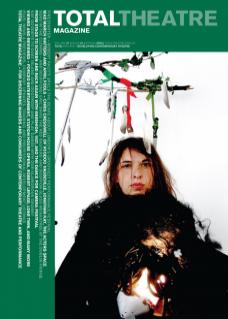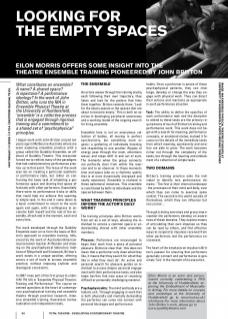What constitutes an ensemble? A name? A shared space? A repertoire? A performance ideology? In the work of John Britton, who runs the MA in Ensemble Physical Theatre at the University of Huddersfield, ‘ensemble’ is a collective process that is engaged through rigorous training and a commitment to a shared set of ‘psychophysical’ principles.
I began work with John Britton around ten years ago in Melbourne Australia where we were exploring ensemble practice with a group called the Quiddity Ensemble, an offshoot of Quiddity Theatre. This encounter forced me to rethink many of the paradigms that had underpinned my performance practice up to that point. The focus of the work was not on creating a particular aesthetic or performance style, but rather on confronting the basic task of inhabiting a performance space and sharing that space effectively with other performers. Essentially there were no performance tricks or skills that could help me achieve this seemingly simple task. In the end it came down to a basic commitment to return to the work again and again, with a willingness to encounter both myself and the rest of the ensemble, afresh and in the moment, each and every time.
The work developed through the Quiddity Ensemble went on to form the basis of Britton’s approach to ensemble training. Influenced by the work of Australian/American improvisation teacher Al Wunder and drawing on the psychophysical laboratory traditions of Meyerhold and Grotowski, Britton’s work exists in a unique position, offering actors a set of tools to access ensemble practice, without imposing stylistic and ideological constraints.
In 2007 I was part of the first group to undertake the MA in ‘Ensemble Physical Theatre: Training and Performance’. The course examined questions at the heart of contemporary psychophysical training and ensemble theatre through practical research, intensive ensemble training, theoretical contextualisation and independent study.
The Ensemble
As actors weave through the training studio, each following their own trajectory, they listen and look for the pattern that links them together. Britton reminds them: ‘Look for the empty spaces or the spaces that are about to become empty.’ This is both an exercise in developing peripheral awareness and a working model of the ongoing search for living ensemble.
Ensemble here is not an anonymous collection of bodies, all moving in perfect synchronicity, but something more organic; a gathering of individuals listening and responding to one another. Ripples of energy pass through the room, attentions waver, and steps shift in and out of sync. The moments when the group connects are perfectly clear from within the exercise and to an observer. In these moments time and space take on a rhythmic quality that is at once dynamically energised and vastly expansive. Ensemble is realised in these ephemeral instances. This ensemble is constituted by both its individuals and the spaces between them.
What Training Principles Inform the Actor’s Daily Work?
The training principles John Britton works from act as a set of keys, allowing the individual to access a common space or understanding shared with other ensemble members.
Pleasure: Performers are encouraged to begin their work from a place of personal pleasure. Britton is clear that: ‘this does not mean that a performer only does what they like, it means that they search for what they like in what they must do’. An active and personal search for pleasure guides an individual to access deeper personal engagement with their performance tasks, and also helps her/him find new ways of revisiting difficult or personally challenging material.
Psychophysicality: The mind and body are a holistic unit. Through engaging in work that is both physically and mentally demanding the performer can come into contact with personal blockages and performance habits. Once a performer is aware of these psychophysical patterns, they can challenge, develop or change the way they engage with physical work. They can direct their actions and reactions as appropriate in each performance situation.
Task: The ability to define the specifics of each performance task and the discipline to attend to these tasks are the primary requirements of much of Britton’s training and performance work. This work does not begin with a search for meaning, performance concepts, or emotional states; instead it focuses on the details of the immediate tasks from which meaning, spontaneity and emotion are able to grow. The work becomes richer not through the complexity of the tasks, but through the layering and embodiment of a collection of simple tasks.
Two Domains
Britton’s training practice asks the individual to identify two performance domains. ‘The first is their internal landscape – the processes of their mind and body, over which they can come to exercise some control. The second is the world outside of themselves, which they can influence but not control…
Through training exercises and group improvisation the performers develop an awareness of these domains. They explore means of articulating their own impulses so they can be read by others, and find effective ways to respond to impulses received from other performers and the performance environment.
The heart of the emphasis on impulse is Britton’s passion for ensuring that performers genuinely connect and performance is genuinely ‘live’ in the moment of its execution. What constitutes an ensemble? A name? A shared space? A repertoire? A performance ideology? In the work of John Britton, who runs the MA in Ensemble Physical Theatre at the University of Huddersfield, ‘ensemble’ is a collective process that is engaged through rigorous training and a commitment to a shared set of ‘psychophysical’ principles.
Eilon Morris is an actor and percussionist currently undertaking a PhD at the University of Huddersfeld, exploring the Embodiment of Musicality in Acting. For more details on courses and workshops at the University of Huddersfeld go to www.hud.ac.uk/ mh/drama For more information about John Britton’s work, please go to www.quidditytheatre.com

